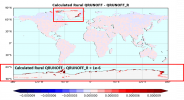Hello, I am learning how to derive landunit-level results from pft-level (finest-level) output. I practiced by calculating the urban, rural (bare soil+veg+crop) and grid-mean air temperature & latent heat flux from pft-level output, and then compare my results with CLM output (TSA_U, TSA, EFLX_LH_TOT_R ect.).
I can correctly get urban,rural and grid-mean air temperature by calculating the area-weighted average values of corresponding pft-level (finest-level) TSA - I knew my results were correct because my calculated urban,rural and grid-mean air temperature were exactly the same with TSA_U, TSA_R and TSA at grid-level.
However, the same area-weighted average algorithm got wrong urban energy flux results. For example, my calculated urban EFLX_LH_TOT from pft-level output were very different from EFLX_LH_TOT_U that CLM output directly. Maybe here urban energy flux should not be calculated as the area-weighted average of pft-level energy flux?
How can we get correct urban and grid-mean energy flux from the pft-level output? Any suggestions are appreciated. Thank you!
I can correctly get urban,rural and grid-mean air temperature by calculating the area-weighted average values of corresponding pft-level (finest-level) TSA - I knew my results were correct because my calculated urban,rural and grid-mean air temperature were exactly the same with TSA_U, TSA_R and TSA at grid-level.
However, the same area-weighted average algorithm got wrong urban energy flux results. For example, my calculated urban EFLX_LH_TOT from pft-level output were very different from EFLX_LH_TOT_U that CLM output directly. Maybe here urban energy flux should not be calculated as the area-weighted average of pft-level energy flux?
How can we get correct urban and grid-mean energy flux from the pft-level output? Any suggestions are appreciated. Thank you!

